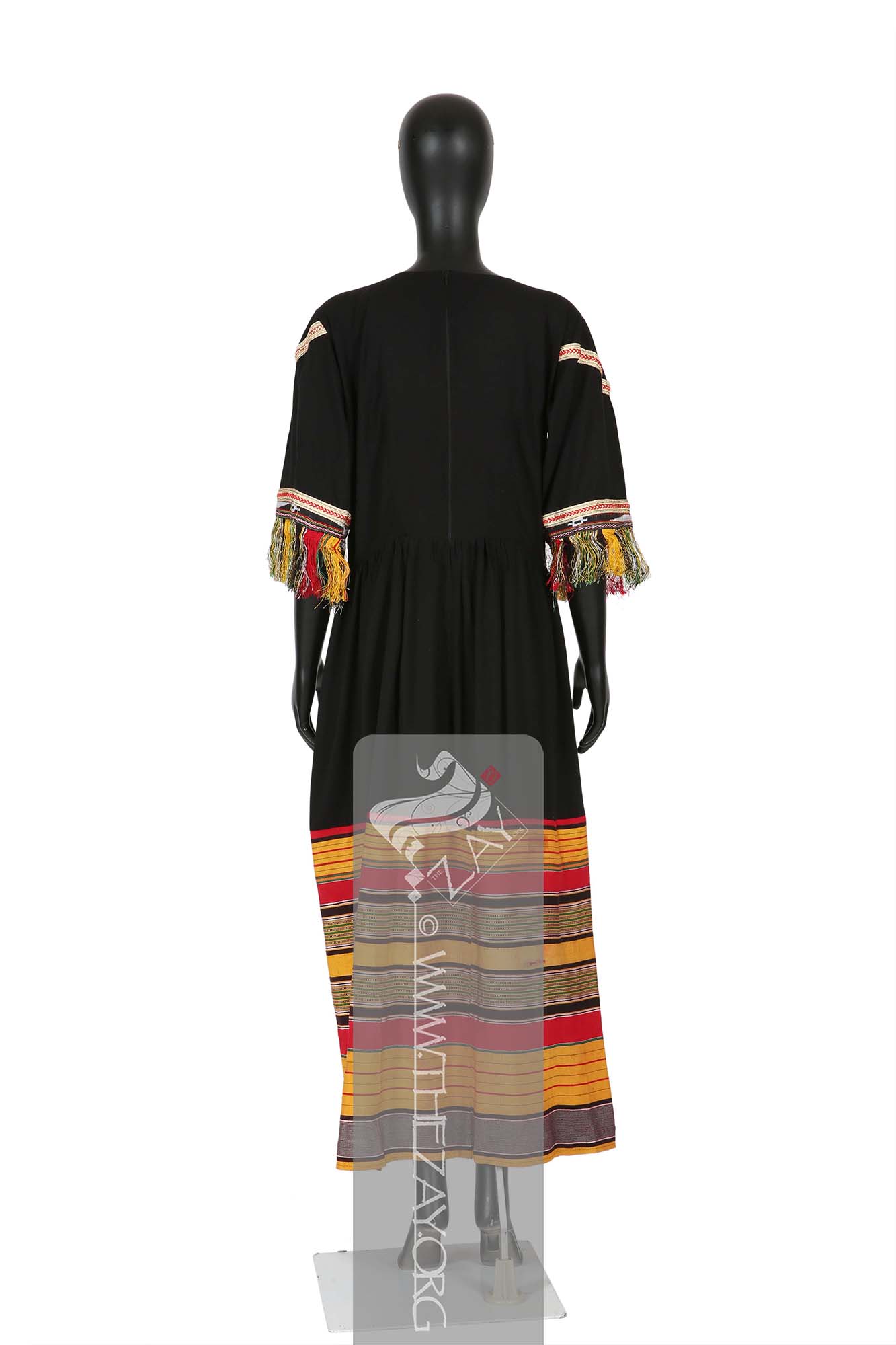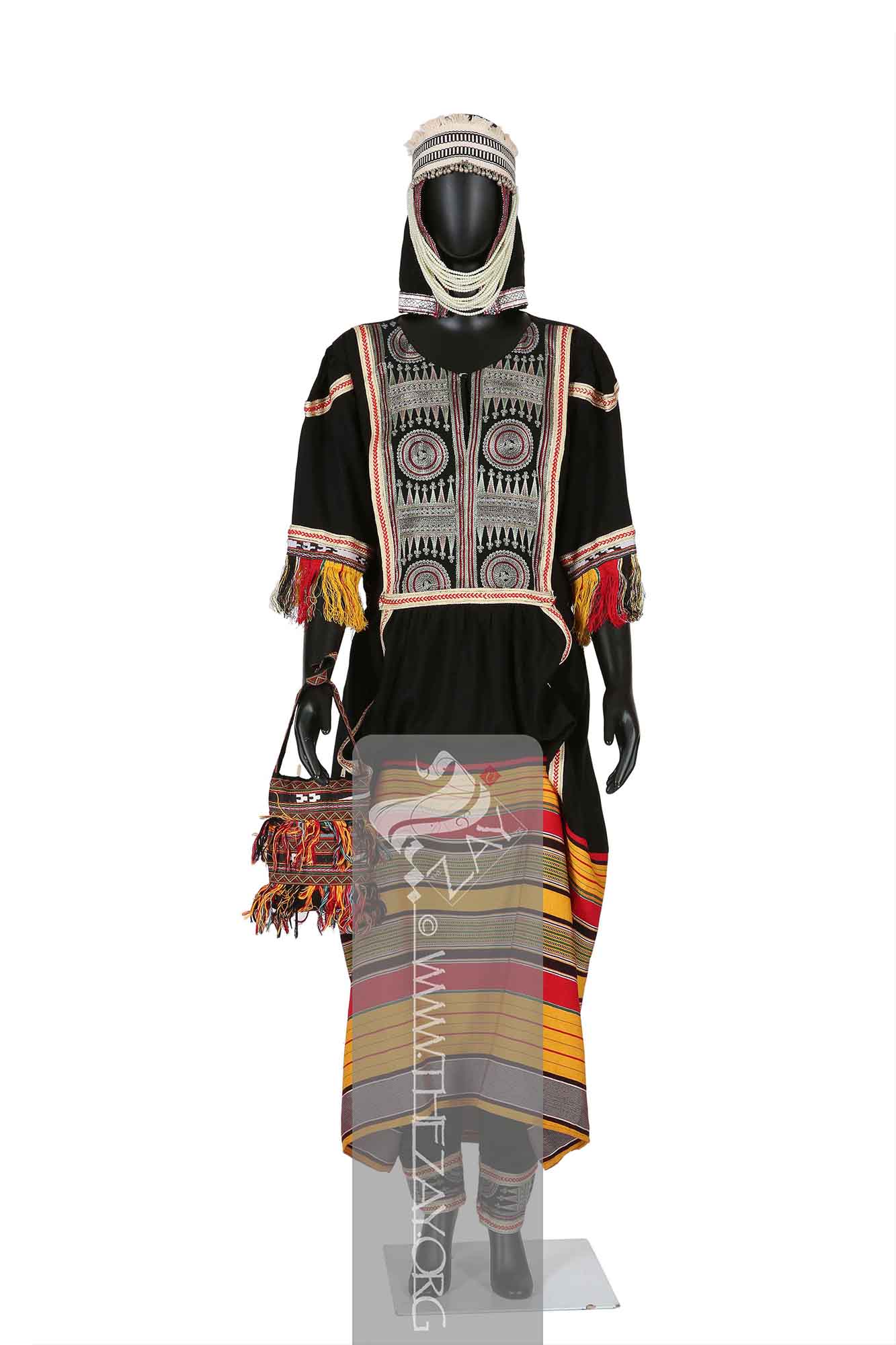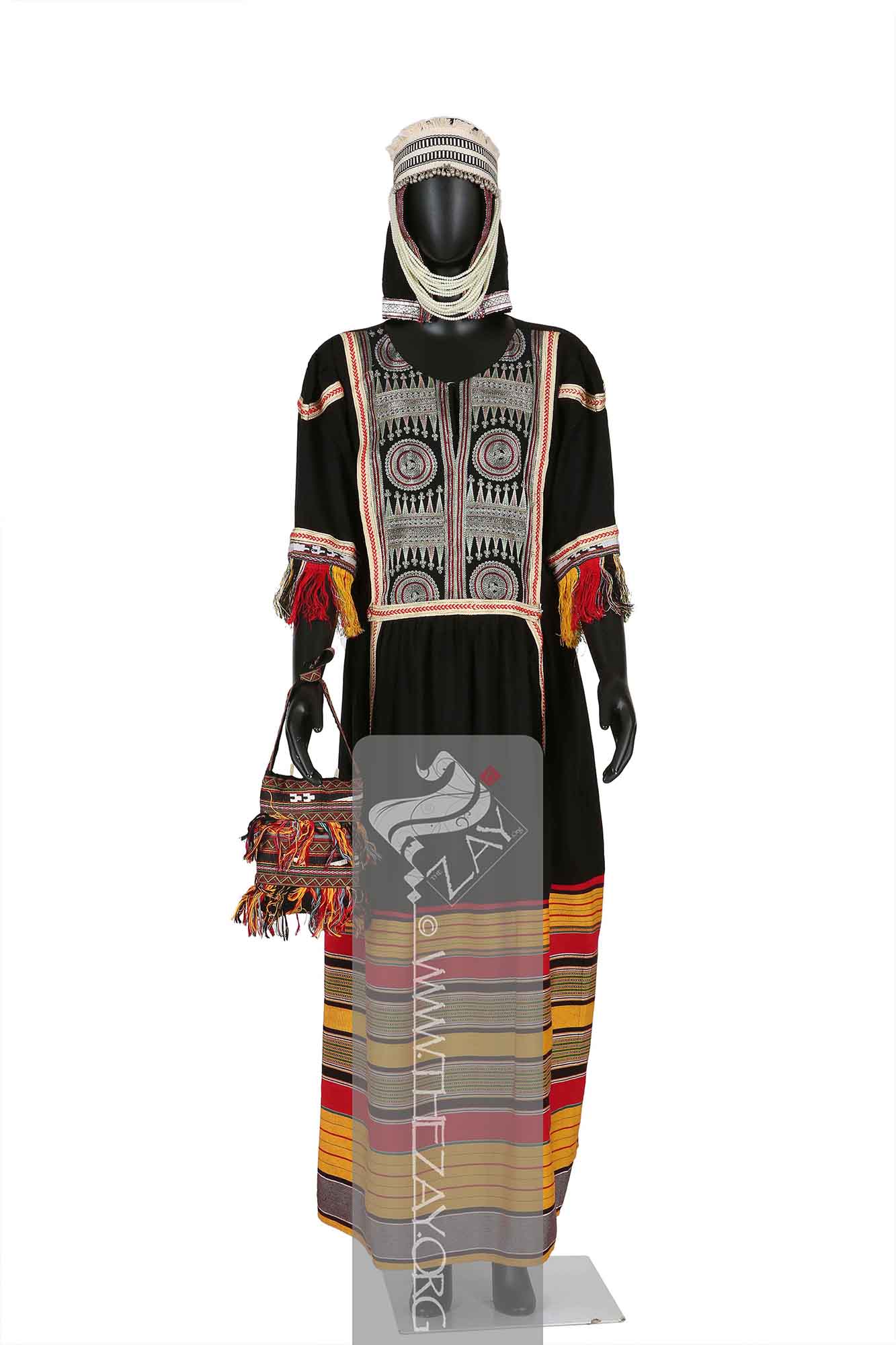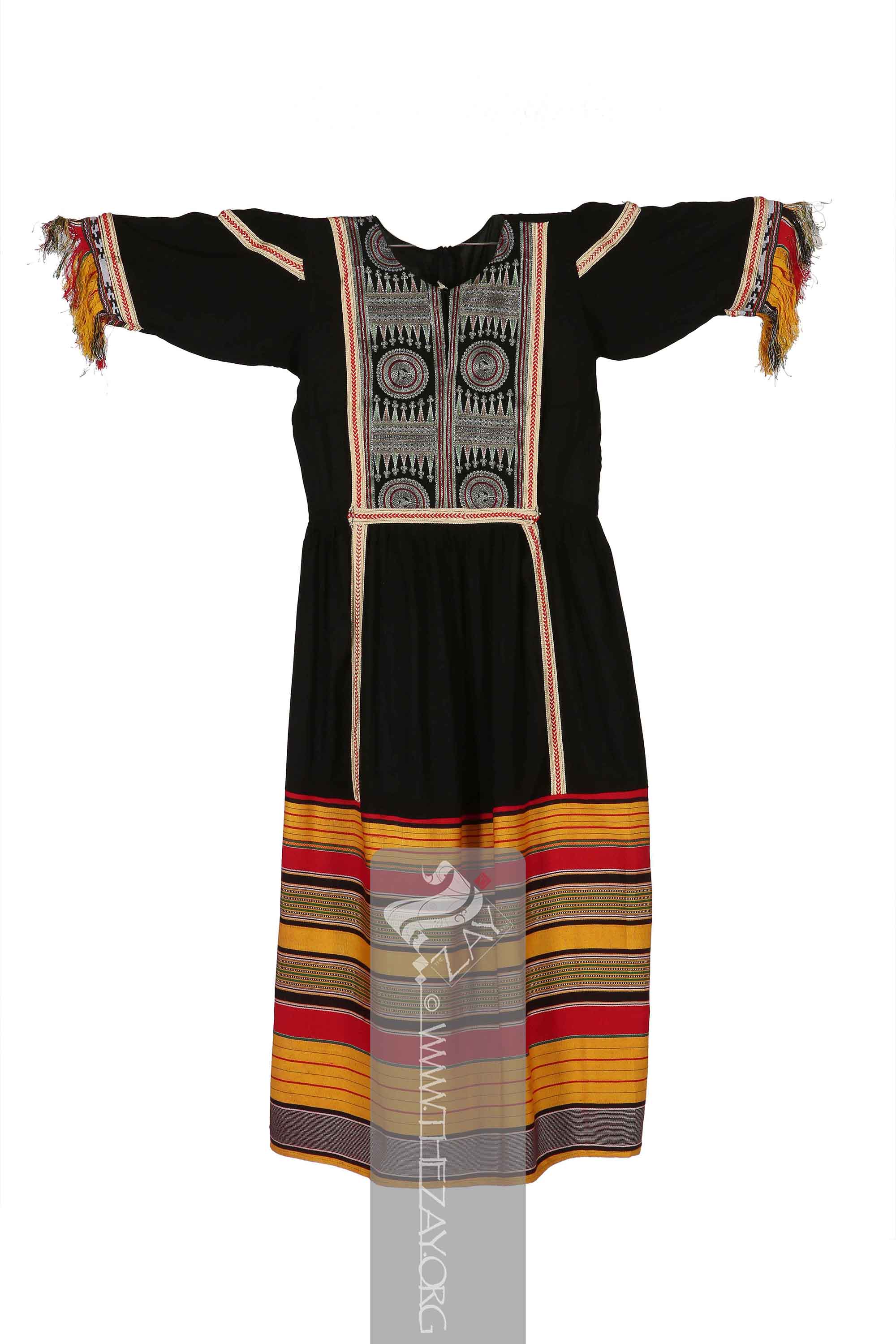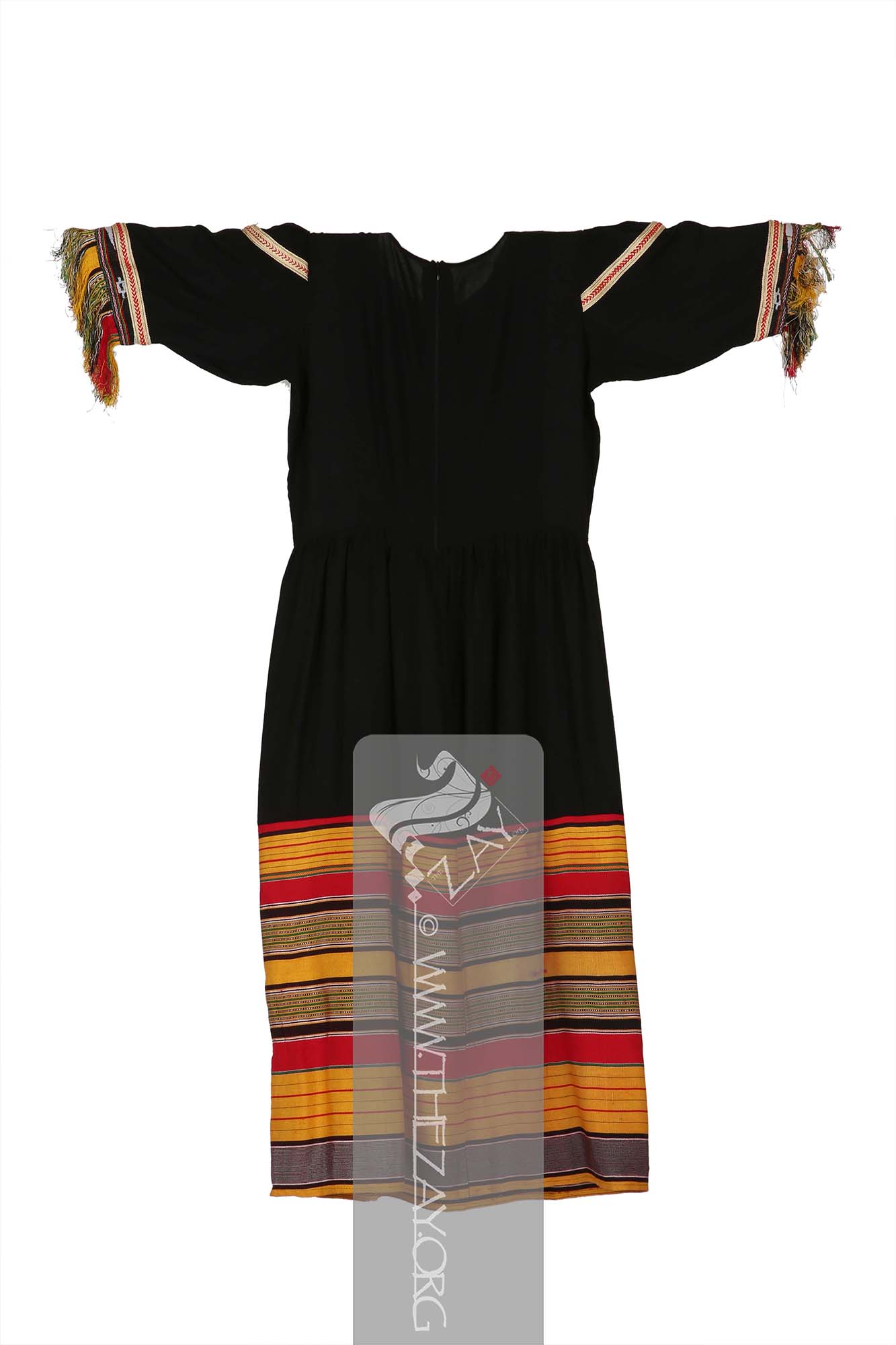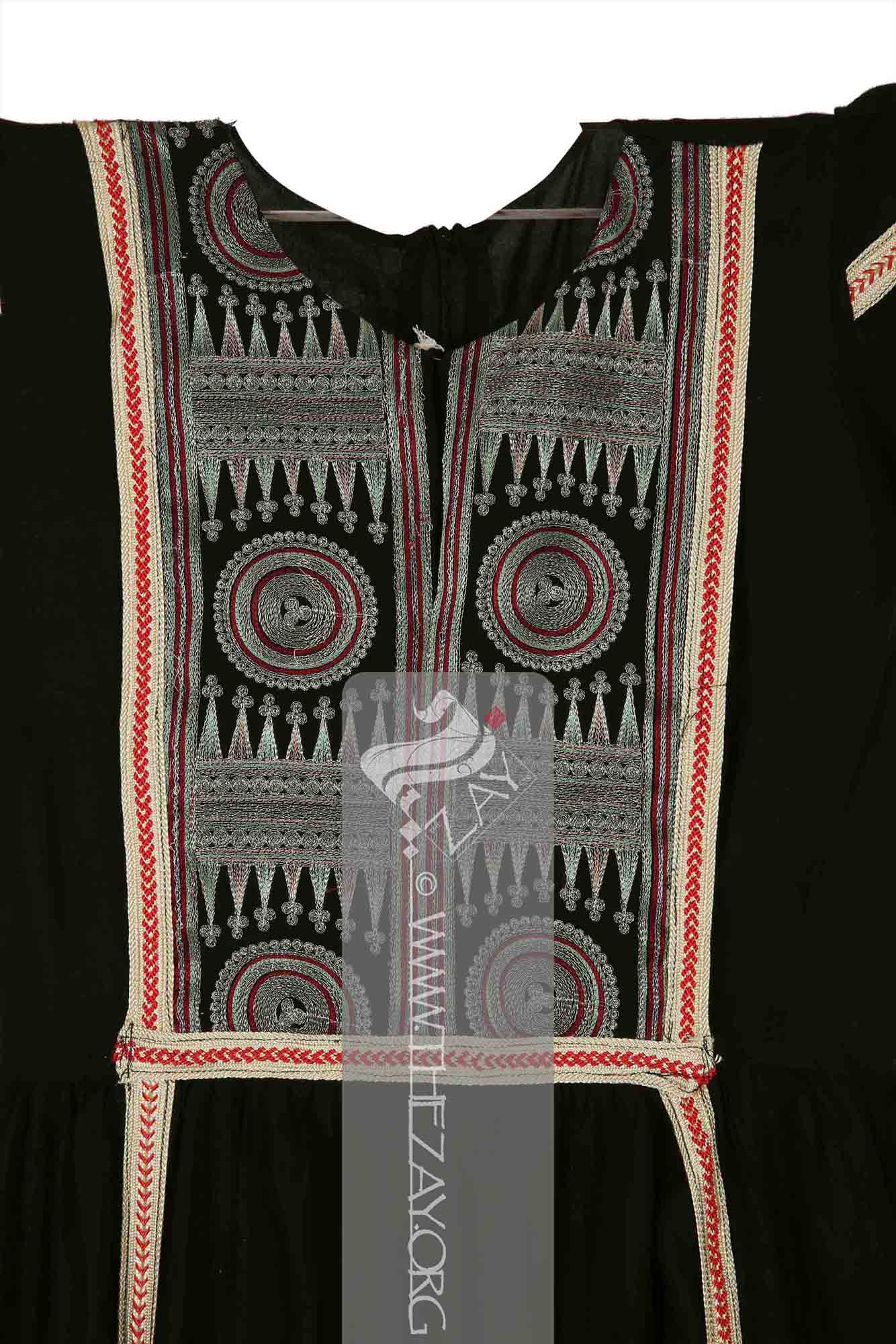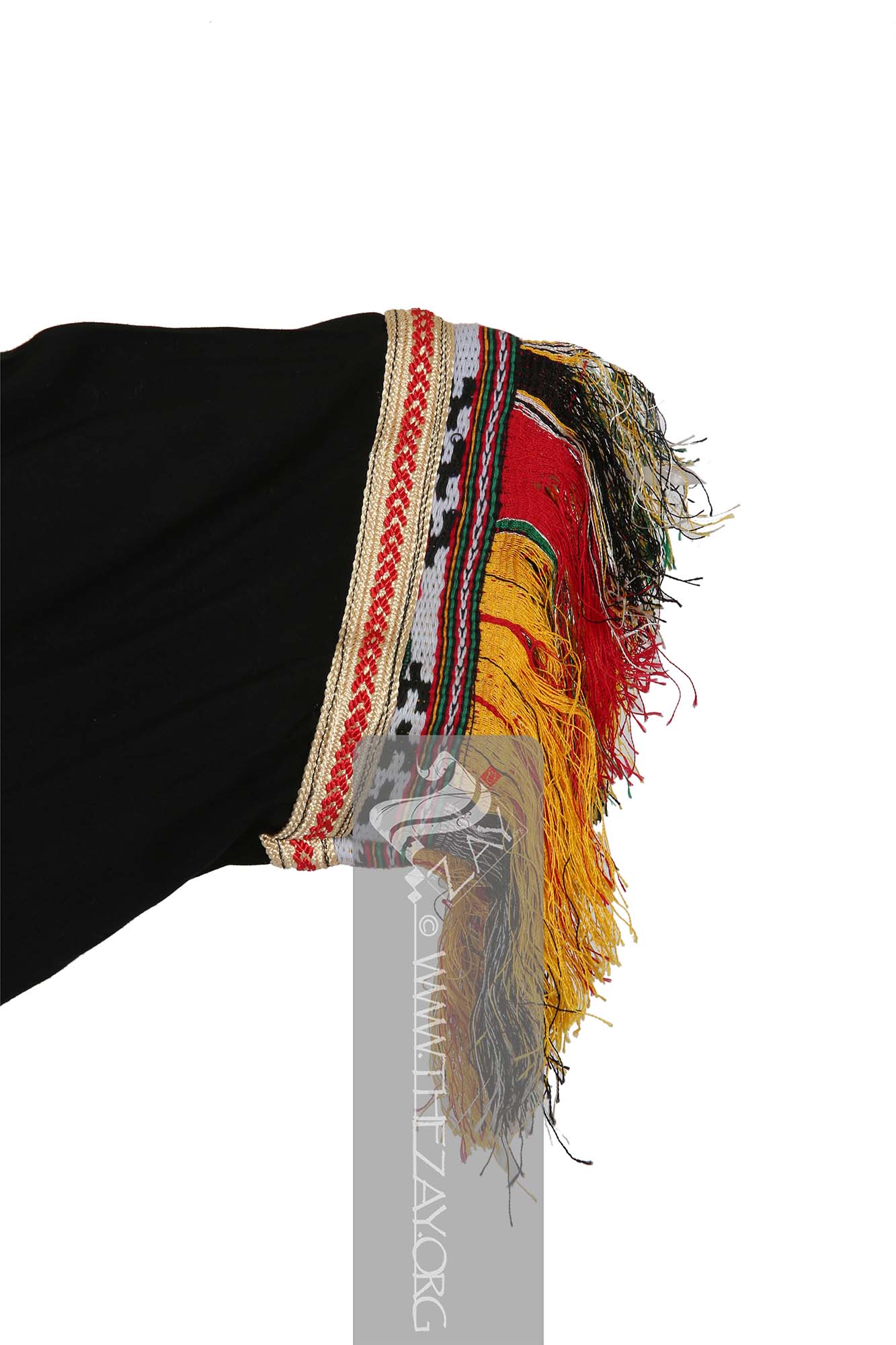Object NoteThis piece (
thawb_al_sawn
Thawb_al_ṣawn: (Arabic: ṣāna: maintain and protect), colloquially refers to a dress worn by Bani Malik tribe, Saudi Arabia. It’s made of plain cotton, recently of satin, and has the shape of a narrow rectangle.) is one part of a five-part ensemble including: undergarment (
sirwal
Sirwāl: (Farsi: shalvār; Synonym: Salwar, Ṣarwāl, sharwāl, salbāl, khalag), pair of trousers with tapering ankles and fastened with a draw string. Believed to have originated in Central Asia it has spread since in the Indian subcontinent between c. 1st – 3rd century BCE and the Middle East from c. 12th century. ) (
ZI2021.500946.1a KSA), headdress (
quba
Qub’a / Qūba’a: (Pl. 'aqbā'a), the part of the clothing that covers the head, a hat and a cap.’ah) (
ZI2021.500946.1b KSA), headband (‘usabah) (
ZI2021.500946.1c) KSA, and flask (
ZI2021.500946.1d KSA). This outfit was purchased together with two other full outfits, Harb tribe
thawb
Thawb: (Arabic: thawb, Pl. Athwāb/thībān), can be pronounced thobe
Thobe: (Arabic: thawb, Pl. Athwāb/thībān), can be pronounced thawb or tobe
Tobe: (Arabic: thawb, Pl. Athwāb/thībān), can be pronounced thawb or thobe based on locale. The standard Arabic word for ‘fabric’ or ‘garment’. It can refer to a qamīs-like tunic worn by men and women in the Arabian Peninsula, Iraq, the southern and south-western ports and islands of Iran, and some countries in East and West Africa. More specifically, it can refer to the square-shaped Bedouin overgarment worn by women. based on locale. The standard Arabic word for ‘fabric’ or ‘garment’. It can also refer to a qamīs-like tunic worn by men and women in the Arabian Peninsula, Iraq, the southern and south-western ports and islands of Iran, and some countries in East and West Africa. More specifically, it can refer to the square-shaped Bedouin overgarment worn by women. or tobe
Tobe: (Arabic: thawb, Pl. Athwāb/thībān), can be pronounced thawb or thobe based on locale. The standard Arabic word for ‘fabric’ or ‘garment’. It can refer to a qamīs-like tunic worn by men and women in the Arabian Peninsula, Iraq, the southern and south-western ports and islands of Iran, and some countries in East and West Africa. More specifically, it can refer to the square-shaped Bedouin overgarment worn by women. based on locale. The standard Arabic word for ‘fabric’ or ‘garment’. It can also refer to a qamīs-like tunic worn by men and women in the Arabian Peninsula, Iraq, the southern and south-western ports and islands of Iran, and some countries in East and West Africa. More specifically, it can refer to the square-shaped Bedouin overgarment worn by women in the Arabian Gulf region. (ZI2021.500946.2 KSA) and Hijazi bridal
thawb
Thawb: (Arabic: thawb, Pl. Athwāb/thībān), can be pronounced thobe
Thobe: (Arabic: thawb, Pl. Athwāb/thībān), can be pronounced thawb or tobe
Tobe: (Arabic: thawb, Pl. Athwāb/thībān), can be pronounced thawb or thobe based on locale. The standard Arabic word for ‘fabric’ or ‘garment’. It can refer to a qamīs-like tunic worn by men and women in the Arabian Peninsula, Iraq, the southern and south-western ports and islands of Iran, and some countries in East and West Africa. More specifically, it can refer to the square-shaped Bedouin overgarment worn by women. based on locale. The standard Arabic word for ‘fabric’ or ‘garment’. It can also refer to a qamīs-like tunic worn by men and women in the Arabian Peninsula, Iraq, the southern and south-western ports and islands of Iran, and some countries in East and West Africa. More specifically, it can refer to the square-shaped Bedouin overgarment worn by women. or tobe
Tobe: (Arabic: thawb, Pl. Athwāb/thībān), can be pronounced thawb or thobe based on locale. The standard Arabic word for ‘fabric’ or ‘garment’. It can refer to a qamīs-like tunic worn by men and women in the Arabian Peninsula, Iraq, the southern and south-western ports and islands of Iran, and some countries in East and West Africa. More specifically, it can refer to the square-shaped Bedouin overgarment worn by women. based on locale. The standard Arabic word for ‘fabric’ or ‘garment’. It can also refer to a qamīs-like tunic worn by men and women in the Arabian Peninsula, Iraq, the southern and south-western ports and islands of Iran, and some countries in East and West Africa. More specifically, it can refer to the square-shaped Bedouin overgarment worn by women in the Arabian Gulf region. (ZI2021.500946.3 KSA).
Object History Once our Digital Archive launched in 2019, people began to reach out to donate, sell, or point out interesting outfits and body adornments to The
Zay
Zay: (Arabic: costume, Pl. azyaā’), a set of clothes in a style typical of a particular country or historical period. team. When the webinar (Traditional Costumes and Heritage of Saudi Arabia) aired in July of 2021, Mr. Zakaria Ahmed, silver and antique dealer from Yemen and close supporter of The
Zay
Zay: (Arabic: costume, Pl. azyaā’), a set of clothes in a style typical of a particular country or historical period. Initiative’s work, managed to source three interesting and complete outfits through his personal connections throughout the region. Though not the highest of quality,
Dr. Reem Tariq
Ṭariq: (Arabic; Synonym: tulle_bi_talli
Tūlle_bi_tallī: (French: Tulle – a city in France where fine material for veil was first made; Turkish: tel – wire; Synonym: tariq; talli; badla; khus_dozi ), series of small metal knots made on a woven net ground as embellishment. The term is commonly used in the North African Arab region specifically in Egypt.
; talli; badla; khus_dozi ), series of small metal knots made on a woven net ground as embellishment. The term is commonly used in the Levant Arab region specifically in Lebanon.
El Mutwalli
Dr. Reem Tariq
Ṭariq: (Arabic; Synonym: tulle_bi_talli
Tūlle_bi_tallī: (French: Tulle – a city in France where fine material for veil was first made; Turkish: tel – wire; Synonym: tariq; talli; badla; khus_dozi ), series of small metal knots made on a woven net ground as embellishment. The term is commonly used in the North African Arab region specifically in Egypt.
; talli; badla; khus_dozi ), series of small metal knots made on a woven net ground as embellishment. The term is commonly used in the Levant Arab region specifically in Lebanon.
el Mutwallī: Founder (CEO) of the Zay
Zay: (Arabic: costume, Pl. azyaā’), a set of clothes in a style typical of a particular country or historical period. Initiative, a public figure, speaker and author. An expert curator and consultant in Islamic art and architecture, interior design, historic costume, and UAE heritage. was very quick to acquire and add them to augment the Saudi section of The
Zay
Zay: (Arabic: costume, Pl. azyaā’), a set of clothes in a style typical of a particular country or historical period. Collection.
Object FeaturesThis waist-cinched dress (
thawb_al_sawn
Thawb_al_ṣawn: (Arabic: ṣāna: maintain and protect), colloquially refers to a dress worn by Bani Malik tribe, Saudi Arabia. It’s made of plain cotton, recently of satin, and has the shape of a narrow rectangle.) is a recent (post-2000) example of the traditional dress worn by the Bani Malik tribe, located east of Al Lith and south of Taif, Saudi Arabia.
Made of plain black cotton, it consists of a
bodice
Bodice: (English: body), or bodices the plural form of body, it is the close-fitting garment meant to cover the body above the waist or the torso. However, it was not until the 17th century that the term became synonymous to women’s undergarment. (
bdinah
Bdinah: (Arabic: bdan: body, synonym: bdan), generally refers to the central body panel on garments in most Arab Gulf dialect. ) with a round fitted neck opening (
jayib
Jayīb (Arabic: jayīb: pocket), refers to pockets or any opening or fold that creates a pocket such as the neckline opening on garments. Pronounced (yayīb) as the letter (jīm) is turned (yah) in colloquial Arab Gulf dialects. ), ankle-length skirt and fitted with a short zipper stitched to the back. The sleeves are mid-length probably to allow room for silver bracelets.
Traditionally,
thawb_al_sawn
Thawb_al_ṣawn: (Arabic: ṣāna: maintain and protect), colloquially refers to a dress worn by Bani Malik tribe, Saudi Arabia. It’s made of plain cotton, recently of satin, and has the shape of a narrow rectangle. was heavily embroidered with beads. However, in this example, a separate rectangular black cotton machine-embroidered fabric with red, green, and orange metallic thread in geometric motifs is
appliqued
Appliqued: (French: appliquer – Apply), ornamental needlework where small pieces of decorative fabric are sewn on to a larger piece to form a pattern. to the
yoke
Yoke: (Synonym: Bodice_Yoke), a structured pattern fitted at the shoulders defining the structure of women’s garments. Introduced in c. 1880s it defines the transition between the upper and lower parts of the garments and can now be found stitched-in where the blouse is separated from the skirt by a horizontal seam. and covers the area between the shoulders and waistline. These motifs include medallions, small circles, triangles, and rectangular lines. This
appliqued
Appliqued: (French: appliquer – Apply), ornamental needlework where small pieces of decorative fabric are sewn on to a larger piece to form a pattern. section is hemmed with ready-made golden trim with a central line of a repeated red chevron motif commonly known as (
bu_nsaiah
Bū_Nsai’ah: (Arabic, bu: diminutive of abu: father, nis’ah
Nis’ah: (Arabic: diminutive of nis’ah: belt), a woven cotton or wool spun flat cord, used to gather and fasten underpants (sirwal
Sirwāl: (Farsi: shalvār; Synonym: Salwar, Ṣarwāl, sharwāl, salbāl, khalag), pair of trousers with tapering ankles and fastened with a draw string. Believed to have originated in Central Asia it has spread since in the Indian subcontinent between c. 1st – 3rd century BCE and the Middle East from c. 12th century. ) around the waist. Also known as (ribqah
Ribqah: (Arabic: noose, pl. ribaq), colloquially in Saudi Arabia, it refers to the cotton cord used to fasten the waistline on underpants (sirwal
Sirwāl: (Farsi: shalvār; Synonym: Salwar, Ṣarwāl, sharwāl, salbāl, khalag), pair of trousers with tapering ankles and fastened with a draw string. Believed to have originated in Central Asia it has spread since in the Indian subcontinent between c. 1st – 3rd century BCE and the Middle East from c. 12th century. ). Also known as (dikka), or (nis’ah).), or (dikkah). The term is also used to denote any chevron motif.: belt), A woven cotton or wool spun flat cord, used to gather and fasten underpants on waist. Also used to denote any chevron motif.) in some Arab Gulf states such as the UAE. A multicoloured woven panel of horizontal stripes in varying widths of yellow, red, black, white, and green composes the skirt. This particular weave closely resembles the hand-woven loin cloth (
wizrah
Wizrah: (Arabic: small garment, synonyms: izār, wizār, fūṭah), refers to a loincloth wrapped around the lower half of the body, between the navel and the knee. Known in the Arabian Peninsula, Iraq, the Horn of Africa (Somalia, Somaliland, Djibouti, Ethiopia, and Eritrea), Indonesia, Malaysia, Bangladesh, Pakistan, and countries in some parts of East Africa and in India.) or (
izar
Izār: (Arabic: azar: to support and strengthen, synonyms: wizrah
Wizrah: (Arabic: small garment, synonyms: izār, wizār, fūṭah), refers to a loincloth wrapped around the lower half of the body, between the navel and the knee. Known in the Arabian Peninsula, Iraq, the Horn of Africa (Somalia, Somaliland, Djibouti, Ethiopia, and Eritrea), Indonesia, Malaysia, Bangladesh, Pakistan, and countries in some parts of East Africa and in India., wizār, fūṭah, sharshaf
Sharshaf: (Ottoman Turkic: çarsaf – bed sheet; Synonym: mlaya, mlyaya, sharsaf), a set of large cloth usually used as a body wrap by women in public.
), refers to a loincloth wrapped around the lower half of the body, between the navel and the knee. Known in the Arabian Peninsula, Iraq, the Horn of Africa (Somalia, Somaliland, Djibouti, Ethiopia, and Eritrea), Indonesia, Malaysia, Bangladesh, Pakistan, and countries in some parts of East Africa and in India.
) that is very common in Southern Saudi Arabia and Yemen.
The shoulders are decorated with a V shaped line of the same gold and red ready-made trim as the
bodice
Bodice: (English: body), or bodices the plural form of body, it is the close-fitting garment meant to cover the body above the waist or the torso. However, it was not until the 17th century that the term became synonymous to women’s undergarment. (
bdinah
Bdinah: (Arabic: bdan: body, synonym: bdan), generally refers to the central body panel on garments in most Arab Gulf dialect. ). The sleeve cuffs are finished with one line of the same trim followed by an additional 5 cm wide colourful woven and fringed trim of yellow, red, black, white, and green geometric patterns.






